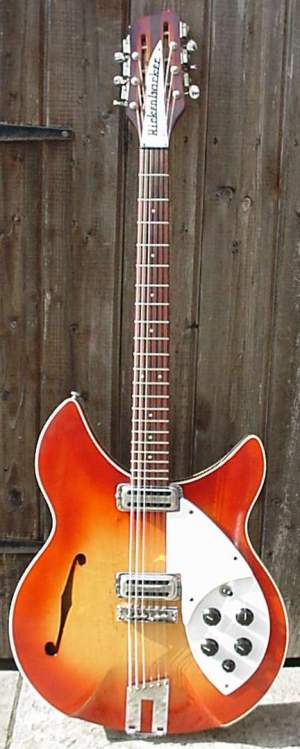
Having searched in vain during the late seventies for a DeLuxe model 360-12 like George Harrison's (double-binding, triangular pearl inlays, stereo wiring, scimitar sound-hole), I eventually saw this advertised in the Melody Maker classifieds in the summer of 1983 and decided to check it out.
I arranged to meet these guys outside West Hampstead tube station. When I arrived, there they were with the guitar, but no case – and well scruffy the instrument looked, too. Like so many of its frail brethren, this Rick had lost its original headstock (though it had been professionally repaired), its badge, and the upper section of its two-tier pick-guard. It was covered in scratches and dings and clearly had done a lot of work, and had not been looked after. I was not impressed!
I had with me a tiny battery-powered practice amp that plugged directly into the jack socket – the pick-ups appeared to work properly but the pots were dirty as all hell. We were at the tyre-kicking stage of the negotiations when I flipped the guitar over to check the serial number on the jack plate. I couldn't believe it – DG 952, my initials and date of birth! I handed them the asking price on the spot, in cash.
At the time I bought this, I hadn't actually realised how few of these guitars were made. Specially ordered by U.K. importers Rose Morris in the summer of 1964 (to cash in on the Beatles' "Hard Day's Night" film success, in which Harrison's Ricky had played a starring role), only 25 were built to this specification before the design was changed to the more familiar "rounded" body contours of late-1964 onwards. The Rose Morris appointments basically changed the U.S. 330 model by adding six more strings, changing the scimitar sound-hole to a more traditional f-hole, and glueing the cream plastic binding to the top and back; hence the 1993 number designation, which was unique to the British supplier. Quite why they insisted on these changes rather than import the stock 360-12 stereo DeLuxe – the George Harrison – is a mystery. Quite possibly the $550 U.S. retail price (in July 1964) might have been a factor. As it was, the original owner of my guitar would have had to shell out £220.10s for it - a serious wedge in those days.
I took it home, stripped everything out of it, cleaned everything and re-soldered a couple of dry joints. It took a while to set up the string action, the intonation and the pick-ups but once the job was done it sprang back to life. What an amazing sound! The following year, I decided to put some money into it and took it to Jonny and Simon Kinkade, who made a new headstock and re-finished the neck. You can't see the join! Mick Wareham (qv) cleverly made a new upper pick-guard, out of some white lucite material supplied by Andy Partridge's then-brother-in-law, Robbie Wyborn. I paid an arm and a leg for a new Rickenbacker case and "correct" headstock badge. And I've since used it on every XTC album from Big Express through to Nonsuch.
You can be sure, I love this guitar. Why, it (almost) has my name on it!
Recording debut: The Three Wise Men - Thanks For Christmas (October 1983)
Features on: All XTC/Dukes Of Stratosphear albums from 1984 to 1992;
Brian Stevens: Disillusioned Days (1994);
Martin Newell: The World Of Dandy Leigh (1994); etc., etc.